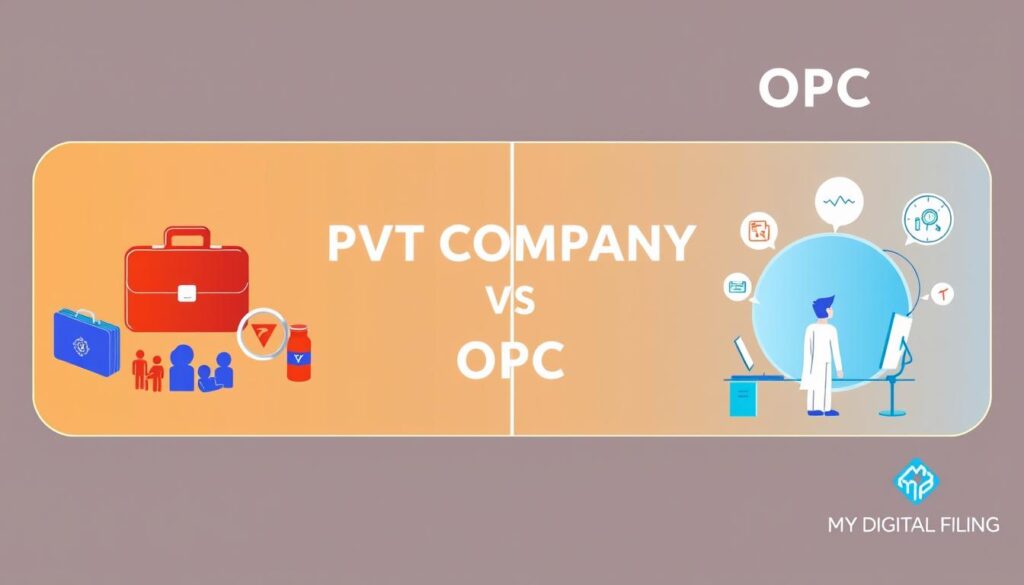Did you know missing the annual compliance deadline can cost your company a lot? For every day late, companies face a penalty of INR 100. For the year 2023-24, companies must file their Financial Statements with Form AOC-4 by 29th October 2024. This is to avoid fines.
One Person Companies (OPCs) have a deadline of 27th September 2024. This shows how important corporate compliance is for your business’s health.
The annual return filing season also marks this time, with Form MGT-7/MGT-7A due 60 days after the AGM. This is on 28th November 2024. Also, audit trail reporting is now required for private companies. This move aims to increase transparency and accountability in corporate governance.
Any delay in holding the AGM can lead to fines and legal issues. It’s crucial to stay on schedule.
Key Takeaways
- Form AOC-4 for financial statements must be filed by 29th October 2024, except for OPCs, which have a deadline of 27th September 2024.
- Annual return (Form MGT-7/MGT-7A) filing due date is 60 days from the AGM, or by 28th November 2024.
- Failure to adhere to the filing deadlines can result in penalties of Rs. 100 per day post-due date.
- Keeping in line with new mandates, companies are encouraged to maintain a detailed audit trail.
- Ensuring timely annual compliance avoids financial penalties and maintains corporate credibility.
Understanding Form AOC-4 and Its Significance
As businesses move towards statutory compliance, knowing Form AOC-4 is key. It’s used for financial statements and disclosures. This form is vital for filing with the Registrar of Companies (RoC) in India.
It helps keep the financial system transparent. This is done through careful record-keeping and checks.
What is Form AOC-4?
Form AOC-4 is required by Indian laws for companies to file their annual financial reports. It’s used by companies following Indian Accounting Standards. This includes non-banking financial companies (NBFCs) and other qualifying businesses.
By filing this form, companies show their financial health to stakeholders and regulators. It’s a key part of corporate compliance every year.
Purpose of Filing Form AOC-4
Filing Form AOC-4 with the ROC is a legal duty. It brings together a company’s year-end finances. This includes profit margins, revenue, and operational costs.
This practice builds trust with shareholders. It also meets legal standards. This helps avoid legal issues and keeps the market’s trust.
Importance of Timely Filing
Filing Form AOC-4 on time is crucial. The deadline for the financial year 2023-24 is October 29th. This keeps companies compliant and avoids fines.
On-time filing shows a company’s commitment to transparency and good governance. It keeps shareholders and investors informed. This can impact investment decisions and business relations.
Form AOC-4 is more than just following rules. It’s key for avoiding legal problems and improving investor relations. It shapes how stakeholders view a company and its market position.
Following the company annual return filing schedule is strategic. It’s not just about following rules. It’s about ensuring growth and stability.
Applicability of Form AOC-4
Understanding Form AOC-4 under the Companies Act, 2013, is key for companies in India. This form ensures companies are transparent and accountable in their financial reports. It’s a crucial part of their annual return submissions.
Companies Required to File AOC-4
All companies under the Companies Act, 2013, must file their annual returns with Form AOC-4. This applies to both public and private companies, regardless of size or sector. Companies with a paid-up capital of Rs. 5 crores or more or an annual turnover of Rs. 100 crores or more must file in XBRL format.
This ensures structured data exchange. Listed companies and those following Indian Accounting Standards also need to file in XBRL. This boosts financial transparency.
Exemptions and Exceptions
However, some companies are exempt from XBRL format requirements. Non-Banking Financial Companies (NBFCs) and firms in banking, insurance, and power sectors are exempt. This makes financial reporting easier for them.
Companies with CSR activities meeting certain criteria must also file CSR-2 with AOC-4. This rule started in the Financial Year 2020-21. It shows more focus on CSR activities of large companies.
The Ministry of Corporate Affairs (MCA) has set a deadline for AOC-4 filing for FY 2023-24. It’s October 29, 2024, or within 30 days of the AGM. Companies must meet this deadline to avoid penalties that could harm their finances.
| Parameter | Requirement |
|---|---|
| Form Type | AOC-4 (XBRL and Non-XBRL) |
| Applicable Entities | All companies under the Companies Act, 2013 |
| Special Exemptions | NBFCs, Banking, Insurance, Power Sector Companies |
| Annual CSR Reporting | Companies meeting specific net worth, turnover, profit thresholds |
| Due Date for FY 2023-24 | October 29, 2024 |
| Filing Format for Large Corporations | XBRL |
Due Date for Filing Form AOC-4 for F.Y. 2023-24
The financial year 2023-24 is important for statutory filing. This includes the Filing form AOC-4 due date for F.Y. 2023-24. Most companies, like One Person Companies (OPCs), must file their annual accounts with Form AOC-4. This is key for annual compliance.
Companies must file Form AOC-4 by 29th October 2024. This ensures they follow the Companies Act 2013. OPCs have an earlier deadline of 27th September 2024.
- The October 2023 compliance calendar helps track these deadlines.
- Regular companies must file Form AOC-4 within 30 days after their AGM.
- OPCs can file within 180 days from the financial year end if they don’t have an AGM.
| Company Type | Due Date | From Date of AGM |
|---|---|---|
| Regular Companies | 29 October 2024 | Within 30 days |
| One Person Company (OPC) | 27 September 2024 | Within 180 days from close of FY |
Knowing and preparing for the Filing form AOC-4 due date for F.Y. 2023-24 is crucial. Not meeting the statutory filing deadlines can lead to penalties. So, remember the date and get your documents ready early.
Consequences of Late Filing or Non-Filing of AOC-4
As a business owner, knowing the rules is key. The deadline for filing Form AOC-4 for FY is set by the Indian Companies Act, 2013. You must file within 30 days after your Annual General Meeting (AGM). Missing this deadline can lead to serious financial and legal issues.
Late Filing Fees and Penalties
The Ministry of Corporate Affairs charges additional fees for late filing of AOC-4. These fees are INR 100 per day. They start right after the deadline and keep going until you file.
Here’s how the fines increase with time:
| Delay Duration | Increased Fee Multiplier |
|---|---|
| Up to 30 Days | 2 times the normal fee |
| More than 30 Days and Up to 60 Days | 4 times the normal fee |
| More than 60 Days and Up to 90 Days | 6 times the normal fee |
| More than 90 Days and Up to 180 Days | 10 times the normal fee |
| More than 180 Days and Up to 270 Days | 12 times the normal fee |
Legal Implications
Missing the AOC-4 deadline can cost you money and lead to legal trouble. This includes fines, disqualification of directors, and even prosecution. It’s crucial to follow the rules to avoid these problems.
The penalty for not filing Form AOC-4 can be up to INR 10 lakh. It’s important to file on time to avoid these high costs.
Knowing the consequences of not holding an AGM on time is vital. Delays in AGM lead to late AOC-4 filing. This creates a cycle of non-compliance. Staying on schedule helps avoid financial and legal issues.
Filing Form AOC-4 Due Date for F.Y. 2023-24
Filing AOC-4 is key for keeping your company in good standing. It ensures your financial reports are up to date. Knowing when to file and how to do it is vital.
Step-by-Step Guide to Filing AOC-4
Here’s a simple guide to help you file AOC-4. First, get the AOC-4 form from the Ministry of Corporate Affairs (MCA) website. Fill it out with your company’s financial details, like the balance sheet and Profit & Loss account.
Also, include Corporate Social Responsibility and related party transactions. Attach the auditor’s report and check that everything meets corporate rules before you submit.
The last step is to upload the form to the MCA portal and pay the fee. You can pay with a Credit Card, Debit Card, Net Banking, or Challan. After paying, make sure you get and keep the acknowledgment slip.
Required Documents and Information
To make filing AOC-4 easier, have these documents ready:
- Audited financial statements
- Board’s report
- Auditor’s report
- Details of penalties or punishment imposed on the company, its directors, or officers, if any
- Information on shares and debentures for the financial year
The deadline for filing AOC-4 for FY 2023-24 is October 30, 2024. Filing late will cost Rs. 100 per day. This can hurt your company’s finances.
Note: Make sure the AOC-4 form matches your financial statements. This supports good corporate governance and compliance.
Difference Between AOC-4 and AOC-4 XBRL
Knowing the difference between AOC-4 and AOC-4 XBRL is key for businesses. It’s about statutory filing of financial statements. AOC-4 is a common form for all companies under the Companies Act, 2013. It’s for submitting financial documents like balance sheets and profit and loss accounts.
AOC-4 XBRL is for a specific group of companies. XBRL, or eXtensible Business Reporting Language, is a digital way to share financial statements. It makes it easier for businesses and regulators to understand each other.
AOC-4 XBRL makes financial data more accurate and reliable. It also meets regulatory needs for transparency. It’s needed for listed companies and some public companies, as per the Companies (Filing of Documents and Forms in Extensible Business Reporting Language) Rules, 2015.
| Form | Description | Mandatory For | Format |
|---|---|---|---|
| AOC-4 | Filing Financial Statements | All Companies | PDF/Physical Forms |
| AOC-4 XBRL | Filing Financial Statements in XBRL | Listed Companies, Certain Public Companies | XBRL |
Businesses must know when to use AOC-4 XBRL. Not using it by 29 October 2024 can lead to big penalties. It’s not just about avoiding fines. Using the right form makes audits easier.
In short, knowing the difference between AOC-4 and AOC-4 XBRL is crucial. As financial reporting changes, following these standards is key for success and transparency.
Applicability of Form AOC-4 XBRL
The applicability of Form AOC-4 XBRL is key for corporate compliance in India. It affects listed companies, their subsidiaries, and others based on size and finances. This rule makes XBRL reporting easier by requiring electronic submissions of financial data.
It’s important for companies with a big capital or high turnover. It also applies to those needing to follow the Companies (Indian Accounting Standards) Rules, 2015.
Corporate compliance through XBRL reporting is more than a rule. It helps keep things clear for shareholders and regulators. It makes sure all financial info is up to date and easy to find.
The deadline for filing Form AOC-4 (XBRL) for FY 2023-24 is 29 October 2024. This is if the Annual General Meeting (AGM) is on 30 September 2024. Filing on time helps avoid big fines. Knowing these dates is crucial for keeping up with corporate compliance.
| Delay Duration | Penalty Factor |
|---|---|
| Up to 30 days | 2 times the normal fees |
| 31 to 60 days | 4 times the normal fees |
| 61 to 90 days | 6 times the normal fees |
| 91 to 180 days | 10 times the normal fees |
| 181 to 270 days | 12 times the normal fees |
Last Date for Conducting the First AGM
It’s important for new companies to know the rules about their first annual general meeting (AGM). The law says the last date of conducting the first AGM must be nine months after the end of the first financial year. For example, if the financial year ends in March, the AGM should be by September 30.
This early AGM lets the company check its early results and make sure it follows the law. It’s a chance to meet all the statutory compliance requirements on time. This avoids fines for not following the rules.
Here’s a table with important dates for every company to remember:
| Compliance Task | Due Date |
|---|---|
| AGM for New Companies | September 30, 2024 |
| Filing Form AOC-4 | October 29, 2024 |
| Filing Form MGT-7/MGT-7A | November 28, 2024 |
| ROC Form MSME-1 (if applicable) | April 30, 2024 |
| ROC Form NDH-3 (Nidhi Company) | April 30, 2024 |
The dates in the table help make sure the annual general meeting and other filings are done on time. This keeps the company in good standing with the law. It also helps build trust with shareholders and the government.
Don’t just see the first AGM as a must-do. See it as a chance to start strong with compliance and good governance. Being well-prepared for this meeting will make future compliance easier.
Last Date for Conducting Subsequent AGMs
The last date of conducting subsequent AGM is a key date for companies. For all companies except One Person Companies (OPCs), they must hold their AGM within six months after their financial year ends. For example, if your year ends in March, you must hold your AGM by September 30th of the same year.
Also, the time between two AGMs should not be more than 15 months. This ensures that the company stays updated with its stakeholders.
Annual General Meetings (AGMs) are vital for corporate compliance. They help keep the business transparent and accountable. Shareholders can talk to the management, check the company’s finances, vote on dividends, and choose new directors.
Meeting the last date for conducting the subsequent AGM is important. It’s not just about following the law. It also helps build trust with investors and shows the company’s commitment to good governance.
If you miss the AGM deadline, you could face penalties. This could harm your company’s reputation and trust with investors and other stakeholders.
Here’s a quick summary of important dates and requirements for your company:
- Deadline to conduct AGM: No later than September 30, 2024
- Director’s KYC compliance deadline: September 30, 2024
- Mandatory Filing of AOC-4 form by: October 29, 2024
In conclusion, the annual general meeting is more than just a legal formality. It’s a key part of good corporate governance. As a director or company secretary, making sure your company meets the last date of conducting subsequent AGM is crucial. It keeps your company in good standing and maintains its reputation.
Attachments Required with Form AOC-4
When you make corporate compliance and financial reporting easier, knowing what attachments are needed with Form AOC-4 is key. For FY 2023-24, submitting on time and with all the right documents is vital. It keeps your company running smoothly and avoids legal problems.
Attachments for Form AOC-4 usually include:
- Audited financial statements for clear financial details
- The Board’s report, giving a full picture of the company’s state
- Auditor’s reports for checking the financials’ accuracy
- CSR activity details, if any, for the year, following the rules for Form CSR-2 by December 31, 2024
To follow corporate compliance rules, make sure all documents are correct and complete. Any mistakes could lead to your filing being checked or even rejected. Meeting the deadlines for AOC-4 and CSR-2 is crucial to avoid fines and keep your company in good standing.
Table: Critical Deadlines for AOC-4 Related Filings
| Form | Due Date | Relevant FY |
|---|---|---|
| Form AOC-4/AOC-4 XBRL & AOC-4 CFS | 29th October 2023 for companies with AGM on 30th September 2023 | FY 2023-24 |
| Form CSR-2 | 31st December 2024 | FY 2023-24 |
Remember, Form AOC-4 is just part of financial reporting. You also need to include audited financial statements and the Board’s report. These are not just required; they are essential for transparency and following the law. As you get your documents ready, make sure they meet all the requirements for a smooth compliance process.
Additional Fees for Late Filing of AOC-4
In India, companies must file their annual financial statements with Form AOC-4. The deadline is 30 days after the annual general meeting (AGM). If they miss this, they face extra fees and penalties.
The ROC late filing fees start at Rs. 100 per day after the deadline. This can add up quickly, especially for long delays. It’s key to know how these fees grow, which can hurt your business’s finances.
Also, the penalty for late annual filing can increase. For example, a late filing can start with a Rs. 10,000 penalty. Then, there’s an extra Rs. 100 for each day it’s late, up to Rs. 2,00,000 for the company and Rs. 50,000 for officers.
The additional fees for late filing of AOC-4 are not just about the financial penalties but reflect negatively on the company’s compliance record, potentially affecting its creditworthiness.
It’s vital to understand the importance of these deadlines and costs. This helps keep your company in good standing and financially healthy. Here’s a look at the fees for different delays:
| Delay Duration (in days) | Late Filing Fee (per day) | Total Fees* (for 30 days) |
|---|---|---|
| 1-30 | Rs. 100 | Rs. 3,000 |
| 31-60 | Rs. 100 | Rs. 6,000 |
| 61-90 | Rs. 100 | Rs. 9,000 |
*This is a simplified illustration and actual fees may vary based on specific circumstances and accumulated days beyond the initial 30.
Being informed and proactive in filing Form AOC-4 can help avoid these high additional fees for late filing of AOC-4. This keeps your company in good standing and financially responsible.
Consequences of Not Holding AGM on Time
Not holding annual general meetings (AGMs) on time can lead to big problems. These issues mainly affect statutory compliance and the timely filing of AOC-4. Knowing these issues can help businesses avoid expensive fines and follow India’s corporate laws.
Impact on AOC-4 Filing
Form AOC-4 is key for showing a company’s financial health to the Registrar of Companies (ROC). Companies must file AOC-4 within 30 days after their AGM. If they miss this deadline, they face financial penalties and legal issues.
Missing the AGM deadline creates big hurdles for companies. These problems can hurt a company’s reputation and make investors lose trust.
Penalties for Non-Compliance
The consequences of not holding AGM on time include big fines. These fines apply not just to AOC-4 but also to other important documents. For example, the fine for late AOC-4 filing can be Rs 100 per day, adding up quickly.
| Document | Standard Filing Deadline | Penalty for Late Filing |
|---|---|---|
| AOC-4 | 30 days post-AGM | Rs 100/day |
| MGT-7A | 60 days post-AGM | Rs 100/day additional late fee |
| Form ADT-1 | 15 days post-AGM | Varies based on delay |
Not having an AGM can cost up to Rs One Lakh for each director or key person. Also, not following AGM rules can lead to a Rs 5000 daily fine from the ROC. Clearly, missing AGM deadlines has serious financial and legal effects.
Penalty for Non-Filing of Form AOC-4
Knowing the penalty for non-filing of form AOC-4 is key for keeping up with corporate compliance. The Registrar of Companies (ROC) strictly enforces ROC penalties to keep things on track.
M/s. Aalamara Nidhi Limited faced big penalties for not filing financial statements on time. The company and its managing directors got hit hard financially because of their delay.
If a company doesn’t fix its mistake within thirty days, it will face more penalties. These penalties are clearly stated in the adjudication order. They show the serious consequences and legal actions that can happen if a company doesn’t comply.
According to Section 137(3) of the Companies Act, 2013, a company gets a starting penalty for non-filing of form AOC-4 of Rs. 10,000. This penalty goes up by Rs. 100 for each day it’s not filed, up to Rs. 2 Lakh. Directors also face penalties starting at Rs. 10,000, plus Rs. 100 daily, up to Rs. 50,000.
Also, NBFCs with a net worth between Rs. 250 crore and Rs. 500 crore must file e-form AOC-4 NBFC by October 29th. The filing fee goes up based on the nominal share capital, from Rs. 200 to Rs. 600. This shows the financial cost of not following rules.
The penalty system is designed to make sure companies follow the rules. It punishes corporate non-compliance. This helps keep the business world transparent and accountable.
Role of Professionals in Ensuring Timely Filing
Meeting the due dates for filings like Form AOC-4 can be tough. Many companies turn to professionals for help to make sure everything is done right and on time. This is key for keeping up with corporate compliance.
Importance of Engaging Professionals
Getting corporate filings wrong can lead to big problems. Chartered accountants and company secretaries have the skills to keep your business in line with the law. They help make sure your business runs smoothly and follows all the rules.
Benefits of Professional Assistance
Getting help from professionals can protect your business from legal issues. Here’s how they can help:
- Expertise in Documentation: They make sure all the right documents are in order for filing.
- Risk Mitigation: They know the laws well and can help protect your filings from trouble.
- Time Management: Letting them handle this task means your business can focus on what it does best.
With professional help, your business can meet its corporate compliance needs. This includes filing the ROC E-Form AOC-4 before the 29th October 2024 deadline.
| Form | Due Date | Professionals’ Role |
|---|---|---|
| ROC E-Form AOC-4 | 29.10.2024 | Ensuring accrual accounting compliance and document verification. |
| Form MGT-14 | 29.10.2024 | Submission of resolutions passed during AGM. |
| Form MSME 1 | 31.10.2024 | Report on payments to MSMEs. |
| Form DIR-3 KYC | 30.09.2024 | Verification and update of director identification details. |
Common Mistakes to Avoid While Filing AOC-4
When filing the AOC-4, it’s key to avoid mistakes for accurate financial reporting. Errors can cause financial issues and legal problems. These problems can harm a company’s reputation and how it works.
One big mistake is putting wrong or missing info in the AOC-4 form. This can cause delays in getting approval. To report finances right, check all numbers and data before you send it. Make sure it matches your audited financial statements.
Filing on time is also very important. If you miss the filing dates, which are from September 27, 2023, to November 30, 2023, you might face penalties. Keep these dates marked in your calendar to stay compliant.
- Document Attachment: Not attaching needed documents is a common mistake. Make sure all required documents are attached before you submit the form.
- Board Meeting Details: Wrongly reporting on board meetings and director approvals can make your filing invalid. It’s important to keep accurate meeting minutes and get the right signatures.
- Directors and Auditors Information: Always provide up-to-date and correct info about directors and auditors. Mistakes here can cause big filing problems.
To avoid AOC-4 filing errors, be detailed and careful with your financial documents. Stick to the Companies Act rules closely.
| Error Type | Common Example | Impact on Filing |
|---|---|---|
| Data Inaccuracy | Mismatching figures in financial statements | Rejection or query from regulatory body |
| Missing Documents | Omission of mandatory director disclosures | Delayed approval process |
| Deadline Miss | Filing after November 30, 2023 | Penalties and compliance issues |
By avoiding these common mistakes in AOC-4 filing, your company can have smoother compliance. This helps avoid penalties and ensures accurate financial reporting. If unsure, consider getting help from a professional to make sure everything is done right and on time.
Conclusion
Complying with statutory filing for the financial year 2023-24 is crucial. It keeps a company’s legal status strong. The deadlines, like the 29th of October 2024 for Form AOC-4, are very important.
Meeting these deadlines shows you follow the Companies Act, 2013. It also helps manage your company’s annual return smoothly.
Knowing about different forms and their deadlines is key. For example, Form AOC-4 for accounts and Form MGT-7/MGT-7A for returns have specific dates. Missing these can cost you Rs. 100 a day.
This shows why you must act fast and prepare well. It’s better to avoid penalties than to deal with them later.
India’s corporate world is strict about following rules. Staying on top of filing deadlines for 2023-24 is essential. It makes your business look good and trustworthy.
Using experts can help. Remember, it’s easier to avoid penalties than to fix them after they happen.
FAQ
Q: What is the filing form AOC-4 due date for F.Y. 2023-24?
A: For the financial year 2023-24, the deadline to file Form AOC-4 is October 29, 2024. One Person Companies (OPCs) have a deadline of September 27, 2024.
Q: What is Form AOC-4?
A: Form AOC-4 is used by companies under the Companies Act, 2013. It’s for filing financial statements with the Registrar of Companies (RoC) each year.
Q: What is the purpose of filing Form AOC-4?
A: Filing Form AOC-4 ensures a company’s financial statements are officially recorded. This reflects transparency and follows statutory requirements.
Q: Why is timely filing of Form AOC-4 important?
A: Timely filing of Form AOC-4 keeps stakeholders informed about the company’s financial health. It also helps avoid penalties and legal issues.
Q: Which companies are required to file AOC-4?
A: All companies under the Companies Act, 2013, including One Person Companies, small companies, and those using Indian Accounting Standards, must file AOC-4.
Q: Are there any exemptions or exceptions for filing AOC-4?
A: Generally, there are no exemptions. However, different forms are used by various companies. For example, AOC-4 XBRL for specific companies and AOC-4 CFS for consolidated financial statements.
Q: What are the consequences of late filing or non-filing of AOC-4?
A: Late filing of AOC-4 incurs a fee of Rs. 100 per day. Non-filing can attract a penalty starting at INR 10,000. It may also lead to legal actions.
Q: How to file Form AOC-4?
A: To file Form AOC-4, download it from the MCA site. Fill in the financial statement data accurately. Then, upload it with required documents. Professional help is recommended.
Q: What documents and information are required to file AOC-4?
A: You need audited financial statements, Board’s report, and auditor’s reports. Ensure all data is accurate and complete before filing.
Q: What is the difference between AOC-4 and AOC-4 XBRL?
A: AOC-4 XBRL requires financial data in an electronically readable format. This is mainly for larger companies or those with specific compliance needs.
Q: Who must file Form AOC-4 XBRL?
A: Listed companies, their subsidiaries, and companies with a certain paid-up capital or turnover must file AOC-4 XBRL. Also, those required to follow Indian Accounting Standards.
Q: When is the last date for conducting the first AGM?
A: The first AGM for new companies must be within nine months of the first financial year. If the year ends in March, it should be by September 30.
Q: What is the last date for conducting subsequent AGMs?
A: Subsequent AGMs must be held within six months of the financial year end. If the year ends in March, it should be by September 30.
Q: What are the required attachments with Form AOC-4?
A: You need the Balance Sheet, Statement of Profit and Loss, Auditor’s Report, Board’s Report, and any explanatory annexure(s).
Q: How much are the additional fees for late filing of AOC-4?
A: The fee for late filing is Rs. 100 per day. Penalties increase based on the delay duration.
Q: What are the consequences of not holding an AGM on time?
A: Not holding an AGM on time can prevent timely AOC-4 filing. It attracts penalties and additional fees. It may also lead to regulatory scrutiny.
Q: What are the penalties for non-filing of Form AOC-4?
A: The penalty starts at INR 10,000. Additional fines of INR 100 per day apply, up to a maximum of INR 2 lakhs.
Q: Why is it important to engage professionals for timely filing of AOC-4?
A: Professionals like chartered accountants or company secretaries are key. They help navigate ROC filing complexities, ensuring accurate reporting and compliance.
Q: What common mistakes should be avoided while filing AOC-4?
A: Avoid entering incorrect financial data, omitting attachments, and missing deadlines. Double-checking and following a checklist can prevent these errors.










